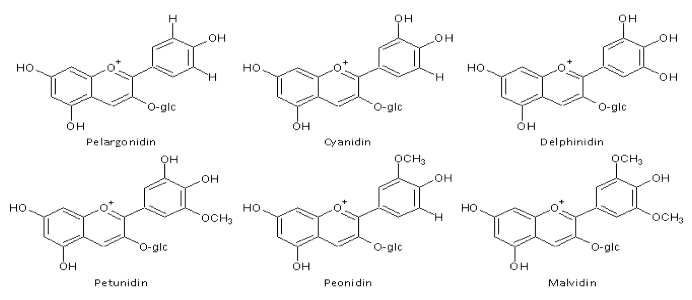Anthocyanins belong to the flavonoids class of the polyphenol. They are contributing to the colors such as red, blue, yellow and purple of many fruits and vegetables. In nature, anthocyanins predominantly exist as glycosides of polymethoxy and polyhydroxy derivatives of flavylium salts or 2-phenyl-benzopyryliurn. Though some anthocyanins can be found in lower plant like mosses and ferns, almost all anthocyanins are found in higher plants. Generally speaking, the anthocyanins found in flowers or ornamental plants are more complex than those in fruits. The anthocyanins in fruits are rather simple and there maybe one or two main pigments in each plant source. However, the pigments in flowers involve a highly regulated series of biochemical steps and undergo both polyglycosylations and polyacylations. Therefore, there are various kinds of anthocyanins in flowers contributing to the variety of shades or hues. In most of the fruits and vegetables, anthocyanins range from 0.1% up to 1.0% of dry weight.

The C ring of anthocyanins is fully unsaturated and there is a hydroxyl at position 3. Anthocyanins are the most oxidized form of flavonoids. The basic structure of anthocyanins is an aglycone or anthocyanidin. Sugars, which sometimes esterified, usually found at C3, C5, or C7. Among the 19 naturally occurring anthocyanidins, cyanidin, malvidin, petunidin, pelargonidin, peonidin, and delphinidin are the most common anthocyanidins identified in edible plants.
Because of the substitution in the B-ring, pelargonidin, cyaniding and delphinidin are the parent aglycone structures of all these naturally occurring anthocyanidins. Glucose, galactose, fructose, rhamnose, xylose and arabinose are the common sugars found in natural anthocyanins. And the most common acyl groups are coumaric, synapic, malonic, acetic, caffeic, ferulic, succinic, oxalic, p-hydroxy benzoic, succinic, oxalic, and malic acids. Taking all these factors into account, there is a quite large number of anthocyanin compounds.
Because anthocyanins can undergo complex modification and structural transformations, it is a real challenge to develop the sensitive and reliable analysis method for anthocyanins. Also, it is difficult to differentiate anthocyanins from other flavonoids because they share similar structures and properties. What’s more, the commercial anthocyanin standards are rarely available.
HPLC is the most popular method used for the qualitative and quantitative analysis of anthocyanins. The unique absorption maximum at ~520 nm for anthocyanins makes it is easy to separate anthocyanins apart from other flavonoids in plant extract, which simplifies procedures for isolation and purification. If there is one position on the B-ring oxygenated, such as pelargonidin, the maximum absorption is at about 520 nm. If there are two positions on the B-ring oxygenated, such as cyanidin and peonidin, the maximum absorption is at about 535 nm. Anthocyanins with three positions oxygenated like delphinidin, petunidin and malvidin, show maximam absorption at 544 nm. Capillary electrophoresis is another method commonly used, because this technique is able to separate complex mixtures of anthocyanins, such as crude plant extracts. Because the powerful separation abilities of CE and the power of MS, CE-MS is and identification and confirmation method of many advantages for anthocyanins.
Platform
- HPLC-UV
Summary
- Identification & Quantification of Anthocyanins
Sample Requirement
- Normal Volume: 500 mg plant tissue
- Minimal Volume: 100 mg plant tissue
Report
- A detailed technical report will be provided at the end of the whole project, including the experiment procedure, MS instrument parameters.
- Analytes are reported as um/ml, while CV's are generally 10%.
- The name of the analytes, abbreviation, formula, molecular weight and CAS# would also be included in the report.
| Anthocyanins Quantified in Our Service | ||
|---|---|---|
| Cyanidin | Delphinidin | Malvidin |
| Petunidin | Pelargonidin | Peonidin |
How to place an order:

*If your organization requires signing of a confidentiality agreement, please contact us by email
With integrated set of separation, characterization, identification and quantification systems featured with excellent robustness & reproducibility, high and ultra-sensitivity, Creative Proteomics provides reliable, rapid and cost-effective anthocyanins targeted metabolomics services.